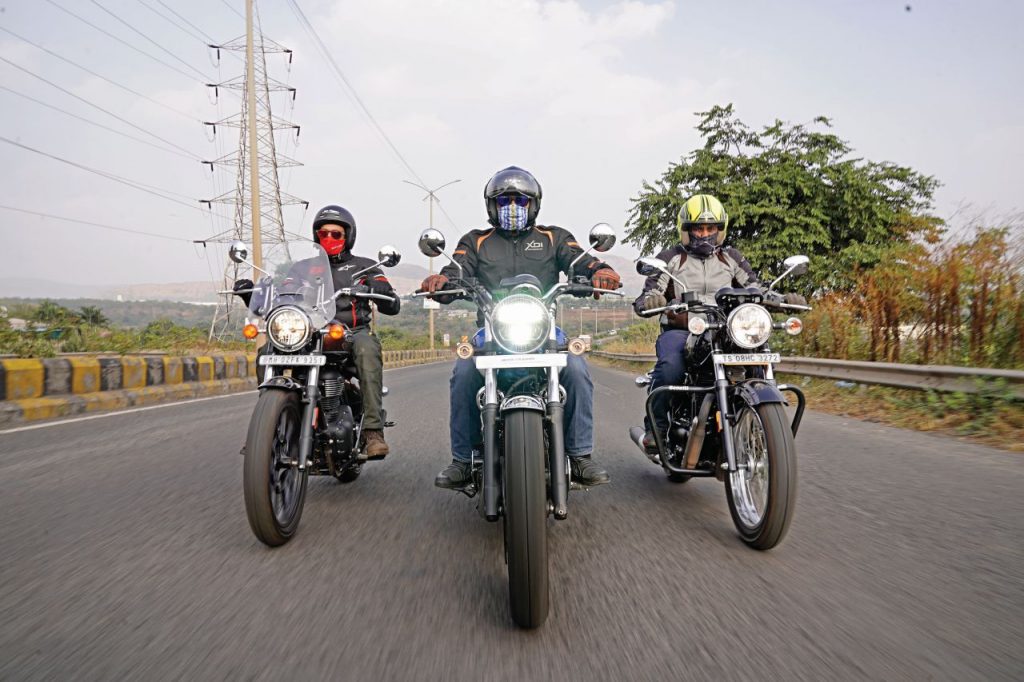
Classically-styled motorcycles are no longer just Royal Enfield’s territory. We take a close look at three bikes vying for the title of the best modern retro
Story: Anosh Khumbatta
Photography: Sanjay Saikar
Usually, when I sit down to write a comparison story, there is a clear winner in my mind; the one motorcycle that stands head and shoulders above the rest and delivers on all the parameters that matter to buyers in the segment. However, it hasn’t been as easy choosing among the three motorcycles here; each of them takes a slightly different approach to capture a share of the growing retro market, and each does a fantastic job in its own right. So, let’s dive right in and see which one comes out on top.
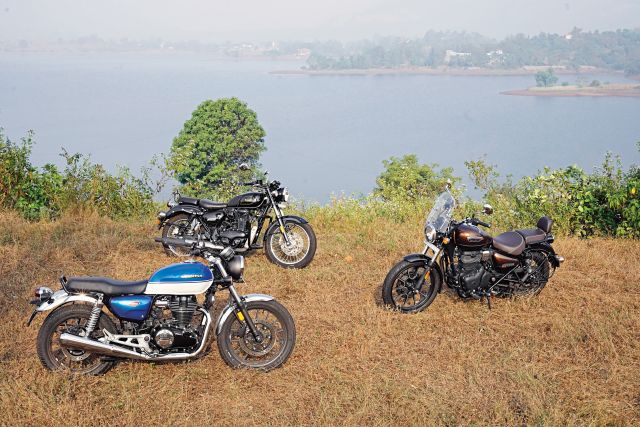
Retro Bike Shootout; The Contenders
Launched a couple of years ago, the Benelli Imperiale 400 is the oldest motorcycle here and was our pick of the retro bikes on sale up to last year. It beat the Royal Enfield Classic 350 at its own game with a smoother motor and better performance, and felt miles ahead of the reborn Jawas. But the game has moved on this year as Royal Enfield’s new Meteor 350 finally brings the manufacturer’s single-cylinder platform into the 21st century, and Honda too are looking for a piece of the action with their oddly named H’ness CB 350.
Retro Bike Shootout; Design, Build and Style
Let’s start with the design, since image is an extremely important consideration for anyone shopping in this segment. The Benelli features the most period-correct look, with its long and low-slung profile, oversized fenders, spoked wheels, and sprung rider’s seat. If authenticity is what you’re looking for in a retro-styled motorcycle, you will naturally gravitate towards the Benelli, which successfully manages to look like it was conceptualized in the 1960s. The Meteor 350 is the spiritual successor to the Royal Enfield Thunderbird and, as such, follows in its predecessor’s footsteps with Royal Enfield’s familiar laid-back cruiser profile featuring a low seat and high handlebars.
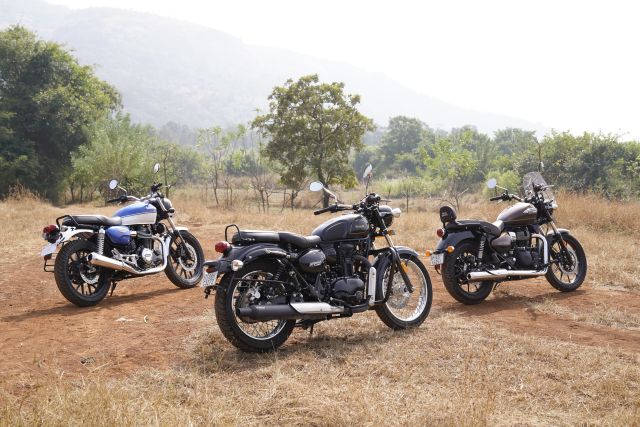
The Honda takes its design cues from the legendary CB series of bikes from the 1970s, although components such as the stylish, Y-spoked alloy wheels, LED headlamp, aluminium foot-peg mounts, and short, upswept exhaust have it looking more like a modern reimagination of an old bike than the other two. The Honda also features the most chrome, is the smallest of the three bikes here, and looks absolutely smashing to me in this blue and white colour combination. Paint finish, build, and component quality are excellent on both the Honda and the RE, while the Benelli is a couple of steps behind in this regard. Looks are subjective, especially in a segment like this where specific tastes and opinions of what a retro bike should look like differ from person to person and, while each of these bikes cuts an imposing figure from just about any angle, I found myself glancing towards the Honda the most.
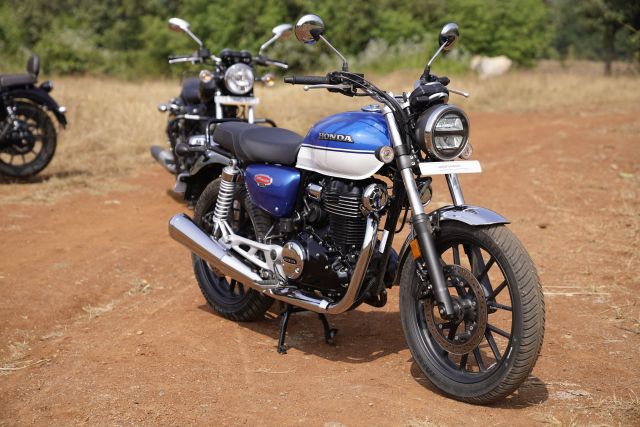
Retro Bike Shootout; Engine and Transmission
Each of these three bikes is powered by a slow-revving, long-stroke, air-cooled single-cylinder motor, mated to a five-speed gearbox and resting within a steel frame. The Meteor goes the double downtube route with the engine acting as a stressed member within the frame, while the other two bikes here feature double-cradle frames supporting the motor. The 374-cc displacement of the Benelli gives it the largest motor here, while the other two bikes stay in the 350-cc ballpark, although the Benelli’s lower 8.5:1 compression ratio versus the 9.5:1 of the other two bikes evens things up when it comes to output. It’s also interesting to note that the Meteor is the only bike here that breathes through a two-valve head, while both the Imperiale and the CB are blessed with more modern four-valve heads, ensuring better combustion.
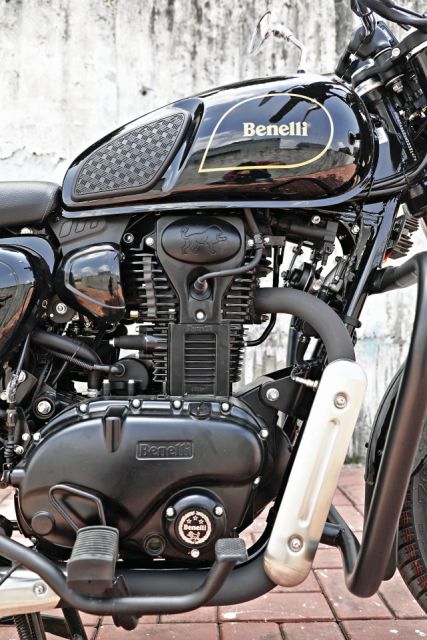
Firing them up, all three bikes have pleasing, single-cylinder exhaust notes and, surprisingly, the Honda sounds the loudest and will definitely bring a smile to your face when you blip the throttle. The transmission on the Royal Enfield is the smoothest and while the Honda’s gearbox feels just as precise, it lacks the tactile feel of the former. The Benelli’s gearbox isn’t as smooth or precise as the other two and the long lever throw gives the transmission a soggy feel.
While on paper all three motors are evenly matched, each one of these machines feels extremely different to ride and comes with its own distinctive personality. Let’s get the numbers out of the way first. The Benelli’s tall motor churns out 29 Nm of torque at 3,500 rpm and 21 hp at 6,000 rpm, Royal Enfield’s new 350-cc platform makes 27 Nm of torque at 4,000 rpm and 20.4 hp at 6,100 rpm, while Honda’s all-new single makes 30 Nm of twist at just 3,000 rpm and 21 hp at 5,500 rpm.
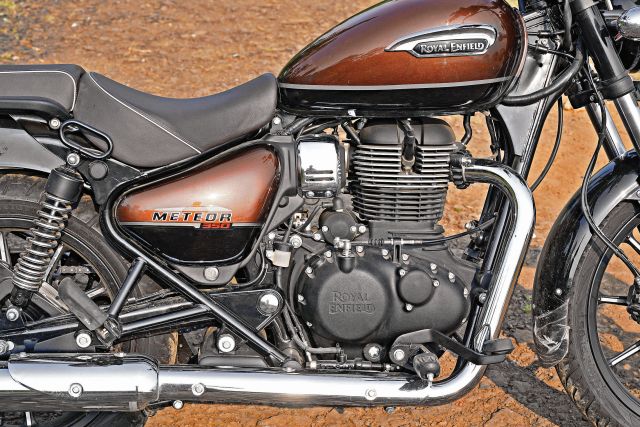
So, the Honda makes the most peak torque, hitting that 30-Nm mark earlier in the rev-range, while its 21 horses are also delivered at lower revs than any bike here. It stands to reason that the CB 350 should be the gruntiest and most tractable of these three bikes in the real world, but that’s not the case. Honda have, for reasons unknown, geared this motorcycle extremely tall; the result is a somewhat lethargic bottom end, necessitating greater levels of rider involvement and a busy left foot to keep the motor in its sweet spot. Quick progress requires you to rev the bike out in each gear, and getting lazy with downshifts around town will have you lugging the motor as it struggles to make torque.
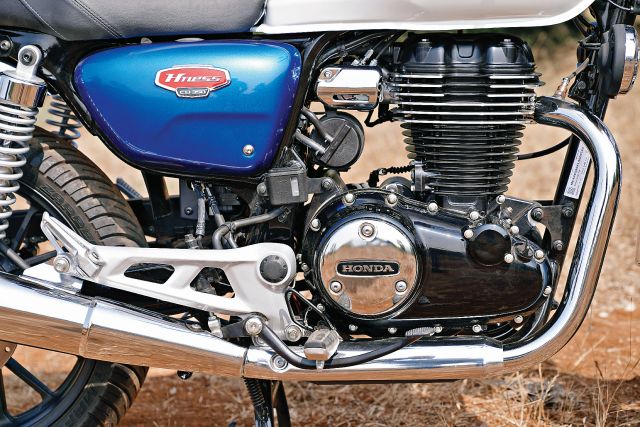
This tall final gearing is the Honda’s Achilles’ heel and, while it is the lightest and quickest accelerating bike here when ridden aggressively, that’s not really how these bikes are meant to be enjoyed. While sportier and more youthful riders might enjoy this level of involvement (I did), such classically styled bikes are aimed at a more mature sort of rider, the kind of rider who is happy to chug along at low revs, with enough torque on tap to accelerate away without needing to downshift. The Benelli and the Royal Enfield follow this brief perfectly with their easy-going nature and more flexible torque delivery, and jumping from the Honda on to either of these two bikes highlights this contrast. You can cruise around town on either of these two bikes slotted into fourth gear with the motors lazily spinning along, occasionally shifting to third if the situation demands. On the Honda, however, you will find yourself dancing between second and third and even occasionally shifting down to first over large speed-breakers or through slow intersections. Of the three, the Meteor’s powertrain is the most flexible and allows you to shift into fifth gear as early as 40 km/h without a hint of knocking. The Benelli is comfortable in fifth at anything over 60 km/h, while the Honda feels quite gutless in top gear even at 80 km/h and doesn’t want to shift up until you’re doing triple-digit speeds on the highway.
Retro Bike Shootout; Ergos, Handling, Performance and Braking
Being the lightest and smallest, of these three bikes, the Honda feels the most nimble in the urban environment, and is the easiest to manoeuvre in traffic and through tight spaces. The Benelli is the longest and heaviest bike here and is hence the most work in the city, especially when making tight U-turns, while the Meteor acquits itself well in the urban jungle, helped along by its low seat height, neutral handling, and stable, planted nature. Each of these bikes also has a very different riding position and this, too, might play a part in the buying decision. The Honda keeps the rider in the most upright and natural position, typical of modern standard motorcycles, while the Benelli’s seating is more authentic and old school, with the foot-pegs directly below the rider and the low, wide handlebar somewhat pulled back. With its low seat, forward-set foot controls and raised handlebar, the Meteor continues with the relaxed cruiser ergos made popular by the Thunderbird.
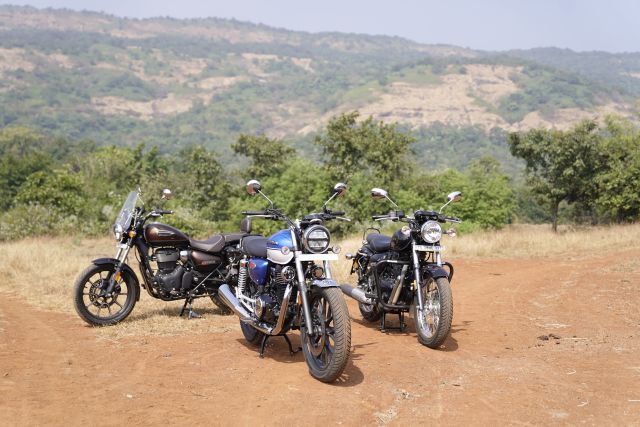
Out on the open road, all three bikes can cruise comfortably at 90 to 110 km/h, but each brings to the table its own individual character. The Benelli feels like the most authentic experience with its period correct design and ergos, and the motor too does feel somewhat lumpy at low revs. However, once you start picking up speed, the ride evens out considerably and the Benelli surprised us all by being the smoothest of these three bikes at 100 km/h in top gear. No vibes filter through at this speed and you can barely hear the motor as it spins away, with enough torque on hand to accelerate effortlessly to 120 km/h with just a gentle twist of the throttle. The Benelli is also the most softly sprung of these three bikes, perhaps too soft up front, but this ensures that small, sharp-edged bumps and undulations are swallowed up without issue and the rider is kept insulated from road imperfections up on the sprung seat. The flipside of this softer suspension set-up is that the Imperiale starts to feel slightly unstable and vague as speed rises, while the other two bikes feel taut and connected to the road.
The Royal Enfield Meteor 350 feels similarly relaxed when rolling along in top gear, although it’s happier cruising closer to 90 km/h. You still have enough torque on tap to make quick overtakes without needing to downshift, although you will feel minor vibrations through the soles of your feet as you accelerate past the triple-digit mark. The relaxed seating position encourages relaxed riding and, while the Meteor has the lowest cruising speed of these three bikes, its easy-going nature makes it a great companion over longer rides and it won’t tire the rider out even after a whole day in the saddle. Coming to ride quality, the firmer suspension means that the Meteor doesn’t insulate the rider from road conditions as well as the Benelli, and the cruiser riding position means that you feel every jolt and bump through your backside as the pegs are too far forward to stand up on. The ride never gets unduly harsh, and the bike always stays extremely stable, planted, and unshakeable on its chosen line. However, you won’t like how it tries to bounce you around when you hit an unexpected bad patch of road at high speed.
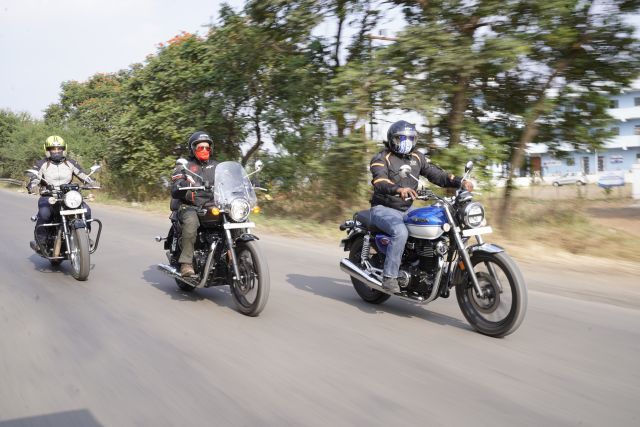
The Honda’s unnecessarily tall gearing has relegated its fifth gear exclusively to overdrive duty. Slotting into fifth at 80 to 110 km/h keeps revs low as the bike trundles along calmly, but rolling on the throttle at this point hardly does anything at all. A downshift is required to make any kind of decent progress, whether it is executing an overtake or just picking up speed at the sight of an empty stretch of road. In fact, the Honda achieves its 130+ km/h indicated top speed in fourth gear and shifting up to fifth will see speed drop and settle at around 120 km/h. It may be the quickest bike here, but it’s definitely not as effortless and relaxed as the other two, and that’s an important consideration for a lot of buyers in this segment. On the suspension front, the Honda seems to be the stiffest of the lot, marginally more taut than the Royal Enfield, but its upright riding position and traditionally placed foot-pegs mean that you can raise yourself off the seat a bit when you see a bad patch of road or a speed-breaker, and let the bike glide right over. The well-damped set-up and short wheelbase also endows the Honda with the most confidence-inspiring handling of the trio, and the front end feels extremely communicative when riding spiritedly. The Royal Enfield Meteor is also extremely well balanced and feels right at home through twisty roads due to its neutral handling, but those low-set foot-pegs limit cornering clearance, and while the Benelli does feel stable and planted over most surfaces, it steers the slowest and that soft front end doesn’t lend the most confident feel.
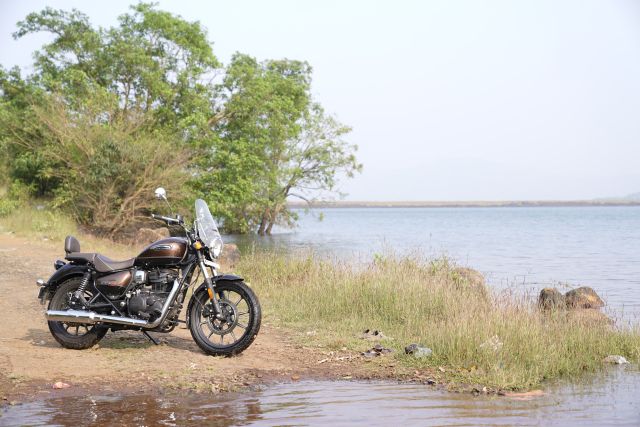
Now, while the Benelli gets so effortlessly to triple-digit speeds, shedding this speed isn’t as easy. The braking system is composed of a 300-mm disc and twin-pot caliper up front supplemented by a 240-mm disc and single-pot caliper at the rear and, while this hardware should ideally get the job done, it feels woefully inadequate when trying to get this heavy bike down from triple-digit speeds. Feel and feedback at the lever leave a lot to be desired, and the only saving grace is the dual-channel ABS that does work quite well. The ByBre brakes on the Royal Enfield and the Nissin units on the Honda feel a lot better and, while the Honda’s brakes have the edge, the chunky levers and oval brake fluid reservoir on the Royal Enfield look and feel a lot more premium.
Retro Bike Shootout; Features
So, we have established that each of these bikes has its own individuality, and while each one excels in different parameters, each one also has its drawbacks. It’s a similar story with their feature lists. The Benelli is the only one of the three with a tachometer, while the Honda is the only one with a trip computer and real-time fuel efficiency display. Both the Honda and the Royal Enfield feature Bluetooth connectivity but, while the former gets a dedicated screen for navigation, it cannot access telephone functions and media. The Honda, on the other hand, can access music, telephone functions and navigation, but the tiny LCD portion within the round speedometer isn’t much help here, and the connectivity options are best used with a headset. The Honda is also the only one with traction control.
Retro Bike Shootout; Verdict
While all three bikes here are designed to evoke nostalgia, the Benelli actually feels the oldest. It loses points for build quality, finish, sub-par braking performance, and its temperamental gearbox, but still managed to impress me greatly with its ride quality and highway performance. Considering these points and the fact that it costs almost 10 grand more than the other two bikes here while offering the least in terms of modern features, the Imperiale 400 looks in need of an update or a price cut before it can challenge the other two on an even footing.
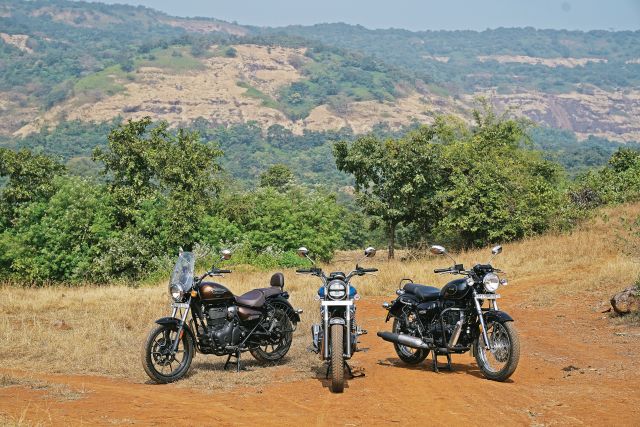
So, it comes down to the Honda H’ness CB 350 and the Royal Enfield Meteor 350. While both these bikes are extremely well-built and do a fantastic job of amalgamating old-world charm and modern technology, they are extremely different to ride and hence will appeal to different kinds of riders. The Meteor carries forward the authentic, relaxed, and torquey character of older-generation Royal Enfields and will appeal to the more mature rider who prefers these old-school motorcycling virtues. So, if you’re the type who likes to sit back on your butt while you effortlessly munch miles in top gear without a care in the world, the Royal Enfield is your winner here. The brand’s extensive dealer network and active rider community are added benefits to owning the Meteor 350.
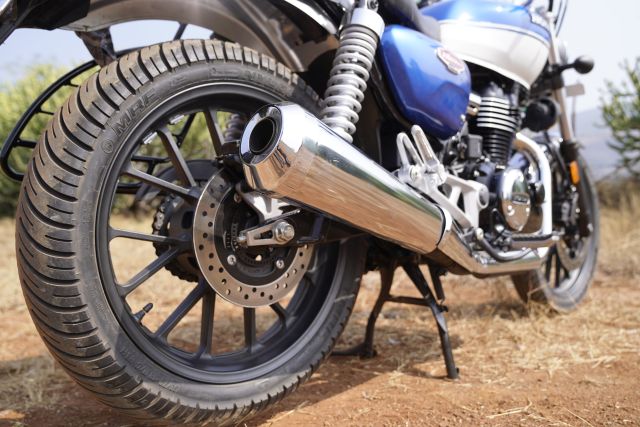
On the other hand, younger riders who are attracted to the classic form but want a bike that feels more modern and energetic will lean towards the Honda. It is ultimately up to rider preference. Personally, I just marginally prefer the level of involvement that comes with riding the Honda, and its playful engine. The Honda is also the best looker in my eyes, as I prefer the standard form and riding position to the Meteor’s cruiser image. If I were to buy the Honda H’ness CB 350, I would certainly shorten the gearing by adding two to three teeth to the rear sprocket, which would make the motorcycle’s overall personality a lot livelier and leave me with nothing to complain about.


Leave a Reply